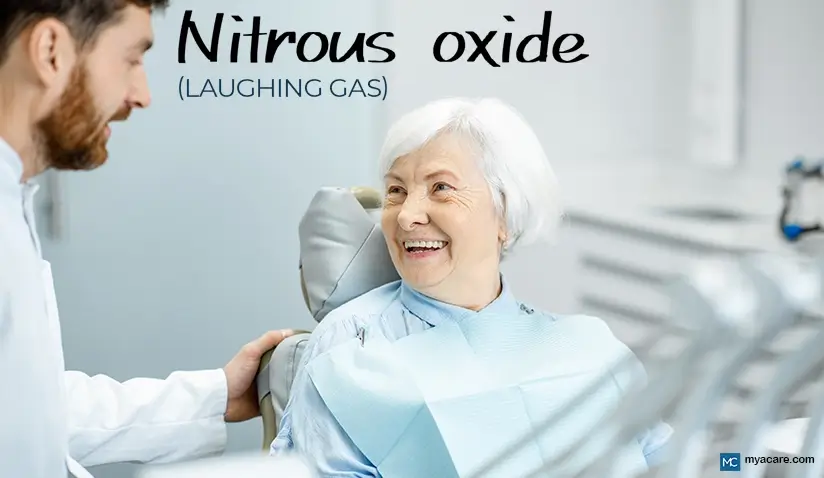Laughing Gas: Applications, Benefits, Limitations, Recent Research and More

Medically Reviewed by Dr. Shilpy Bhandari
What exactly is nitrous oxide, and how does it work? Nitrous oxide, or “laughing gas,” has medical roots in dentistry for over a century. It is a colorless and odorless gas inhaled through a mask to relieve sedation and pain during dental procedures.
In this article, we will explore nitrous oxide's effects and broader applications in the medical field.
What is Nitrous Oxide?
Nitrous oxide is a chemical compound with the formula N2O, discovered by Joseph Priestley in 1772[1]. It is gaseous at room temperature and is commonly used as an anesthetic and analgesic in dentistry to help keep the patient calm. Dentists may also use nitrous oxide during procedures to suppress the gag reflex and lower the anesthetic necessary for pain relief[2].
Inhaled nitrous oxide swiftly floods the brain and body after entering the bloodstream. It binds to receptors in the brain that are responsible for pain and anxiety, including NMDA and opioid receptors. It may also promote GABA and regulate norepinephrine[3]. These effects result in relaxation and euphoria, making it an effective sedative for dental procedures. It also has a numbing effect, reducing the sensation of pain during the procedure.
In the bloodstream, nitrous oxide may promote vasodilation similar to that of nitric oxide (NO), a gas that performs many vital biological functions in the body. While similar, the two gases are different, and nitrous oxide does not substitute for nitric oxide.
Nitrous oxide is inhaled through a mask that covers the nose and mouth. The administered gas contains a proportion of nitrous oxide and oxygen. The effects of nitrous oxide are felt within minutes and are adjustable by the dentist throughout the procedure.
Broader Applications of Nitrous Oxide
While nitrous oxide has typical applications in dentistry, it also has potential in other medical fields.
Its sedative and pain-relieving properties make it a valuable tool in minor surgeries, traumatic emergency procedures, injections, uncomfortable procedures, and childbirth[4]. Examples include:
- Botox, filler, or hyaluronic acid injections[5]
- Skin laser treatments
- Insertion of intrauterine devices (IUDs)[6]
It has also been used and tested in the following applications[7]:
- Anxiety
- Depression
- Schizophrenia
- Alcohol withdrawal
- Opioid withdrawal
- Tourette syndrome
- Spasmodic torticollis
Without a prescription or medical supervision, the use of nitrous oxide can be dangerous.
Nitrous oxide can be prescribed as a therapeutic for depression or anxiety only by experienced psychotherapists, psychiatrists, or similarly qualified professionals who can assess your case.
What to Expect Before, During, and After Using Nitrous Oxide
Before using nitrous oxide, the dentist will review the patient's medical history and discuss potential risks or concerns. A typical recommendation is to avoid eating or drinking for at least 2 hours before and after using nitrous oxide to reduce the risk of any potential nausea or vomiting.
During the procedure, the patient breathes normally with the mask on, and the dentist monitors their response. Nitrous oxide can also be dispensed through a laryngeal or endotracheal tube.[8]
The effects of nitrous oxide appear within 2-5 minutes after inhaling the gas.
The patient receives a concentration of 30-50% nitrous oxide for dental and 50-70% for more intensive procedures. It is often administered when the patient remains conscious, yet may enhance the effects of other anesthetic agents during more intensive procedures that require the patient to be unconscious.
The impact of nitrous oxide wears off within minutes after gas administration stops, and the patient can resume most activities. However, It is advisable to wait at least 15 minutes before leaving the dental office to ensure full alertness. As nitrous oxide can impair coordination and reaction time, it is important to have a designated driver or arrange for transportation after the procedure.[9]
What Does Nitrous Oxide Feel Like?
While nitrous oxide is commonly known as "laughing gas", it does not necessarily make you laugh.
The effects of nitrous oxide differ from person to person. Some may feel a sense of relaxation and euphoria, while others may feel drowsy or lightheaded.
It is essential to remain calm during the procedure and communicate any discomfort or concerns with the dentist.
Benefits of Nitrous Oxide
Nitrous oxide offers several benefits for patients and dentists. These include:
- Reduced anxiety and a more positive overall experience
- It is the fastest-acting anesthetic agent
- Quick onset and adjustment of effects
- Pain reduction
- Lower anesthetic requirements for other anesthetics needed during any given procedure
- Enhanced uptake of arterial oxygen by promoting vasodilation
- Rapid elimination from the brain and body, minimizing anesthesia-related risks, and promoting a swift recovery
- No needles or injections
- No lingering effects after the procedure
Is Nitrous Oxide Safe?
Nitrous oxide is generally safe for most patients, making it a good option for those who experience anxiety or fear during dental procedures. It is also a good option for patients with low pain tolerance or sensitive teeth.
Doctors may offer up to 50% nitrous oxide for lowering the stress and pain intensity associated with labor or during post-natal perineal incision and repair. The infant rapidly eliminates the gas after breathing commences.
Who Should Not Use Nitrous Oxide?
While nitrous oxide is generally safe, it is not suitable for everyone. A frequent contraindication includes pregnancy, as the effects of nitrous oxide on a developing fetus are not fully understood.[10]
Uncontrolled, frequent use may cause congenital anomalies, miscarriage, and lower fertility.[11]
Other risk factors that may place you at a higher risk for laughing gas side effects include:
- Respiratory conditions, such as asthma or COPD
- Pneumothorax (collapsed lung)
- B vitamin deficiencies, especially vitamin B-12 and folate
- Genetic MTHFR (Methylenetetrahydrofolate reductase) deficiency
- Mental health disorders
- Advanced heart disease
- Substance abuse
- Eye surgery involving gas bubbles
- Middle ear surgery
- Bowel obstruction
Nitrous oxide can increase blood homocysteine levels by impairing B vitamin metabolism[12], which may lead to hypertension and blood clots in susceptible individuals. Repeated use may induce megaloblastic anemia (related to cobalamin deficiency). Administration of B vitamins alongside nitrous oxide can substantially lower the risk of hyperhomocysteinemia. Despite B vitamin administration, nitrous oxide may increase cardiac troponin levels[13], which is a marker of heart damage and is not suitable for those with advanced heart disease[14].
It is unsuitable for all types of surgery, particularly endovascular procedures and laparoscopy, as it may cause further complications related to nitrous gas accumulation.
It may lead to temporary hallucinations and dreaming after the procedure, which can intensify symptoms in those with advanced psychiatric illness.
Is it Safe for Kids to Use Nitrous Oxide?
Nitrous oxide frequently benefits children during dental procedures, as it is a safe and effective way to reduce anxiety and pain during procedures. However, the dentist must monitor the child's response and adjust the dosage accordingly.
Limitations of Nitrous Oxide
While nitrous oxide has many benefits, it also has some limitations. These include:
- Not suitable for all patients
- It does not provide enough pain relief for the most invasive procedures
- It can cause nausea or dizziness in some individuals
Safety Considerations and Risks
Nitrous oxide is generally considered safe, yet there are some risks and side effects. These include:
- Nausea or vomiting (more common in procedures over 2 hours long)
- Dizziness or lightheadedness
- Headache
- A fever
- Difficulty breathing
- High homocysteine levels and hypertension
- Allergic reaction
- Potential for abuse or addiction
Nitrous oxide should only be administered by a qualified healthcare professional who can supervise its use, ensure the correct dosage, and reduce the risks involved.
In larger quantities, it can depress the central nervous system, leading to unconsciousness and labored breathing. If the concentration exceeds 75%, the patient can suffer the effects of severe oxygen deprivation. For this reason, it is not safe to use nitrous oxide at a concentration higher than 70% or with other sedatives, opioids, nervous system depressants, or narcotics. A qualified anesthetist knows which anesthetics are compatible with nitrous oxides and which may enhance these effects.
It may also reduce oxygen intake upon cessation, leading to suffocation as the lungs attempt to expel nitrous oxide. The patient receives oxygen during their recovery from nitrous oxide use.
If exposure to nitrous oxide is too great, it may give rise to subclinical small fiber neuropathy, which can lead to numbness or burning sensations[15]. This complication is rare and often reversible.
It is essential to consult with a dentist about any potential risks or concerns before using nitrous oxide.
Exploring Alternatives to Nitrous Oxide
While nitrous oxide is a common sedative in dentistry, other options are available. These include:
- Topical anesthetics, such as numbing gels or sprays
- Local injections
- Oral sedatives
- Cognitive-behavioral therapy (CBT)
- Relaxation tactics, such as deep breathing exercises
Discussing the options with a dentist is meaningful to determine the best course of action.
Advancements in Nitrous Oxide Technology and Applications
Research has significantly advanced our understanding of the mechanisms behind nitrous oxide's effects on the brain and body. These new insights have improved the administration of nitrous oxide, particularly alongside other anesthetic agents[16] and for patients with special needs[17].
While some debate exists within the scientific community regarding its long-term effects with frequent use[18], nitrous oxide's potential for treating depression is currently under investigation through clinical trials. These studies suggest that nitrous oxide may offer a rapid-acting and effective option for people suffering from treatment-resistant forms of depression[19].
Conclusion
Nitrous oxide has had applications in dentistry for over a century for its sedative and pain-relieving properties. While it has common uses in dentistry, it also has potential in other medical fields. It is beneficial to discuss the potential risks or concerns with the dentist before using nitrous oxide. With advancements in technology, nitrous oxide proves to be a safe, practical option for sedation in dentistry.
To search for the best dentists in Germany, India, Malaysia, Poland, Singapore, Spain, Thailand, Turkey, the UAE, the UK and the USA, please use the Mya Care search engine.
To search for the best healthcare providers worldwide, please use the Mya Care search engine.
The Mya Care Editorial Team comprises medical doctors and qualified professionals with a background in healthcare, dedicated to delivering trustworthy, evidence-based health content.
Our team draws on authoritative sources, including systematic reviews published in top-tier medical journals, the latest academic and professional books by renowned experts, and official guidelines from authoritative global health organizations. This rigorous process ensures every article reflects current medical standards and is regularly updated to include the latest healthcare insights.

Dr. Shilpy Bhandari is an experienced dental surgeon, with specialization in periodontics and implantology. She received her graduate and postgraduate education from Rajiv Gandhi University of Health Sciences in India. Besides her private practice, she enjoys writing on medical topics. She is also interested in evidence-based academic writing and has published several articles in international journals.
Sources:
Featured Blogs



